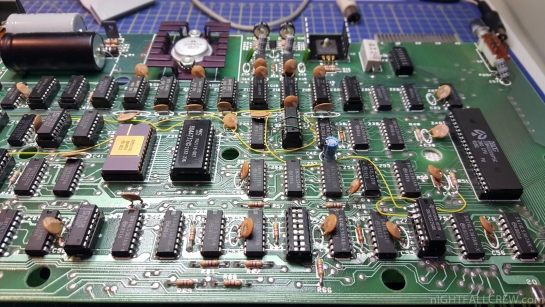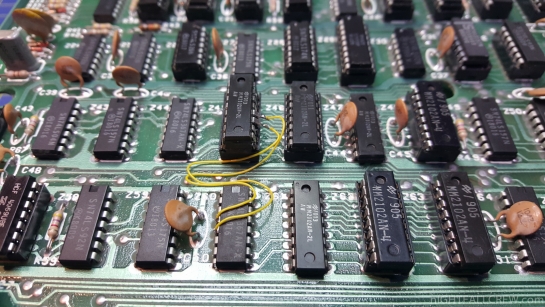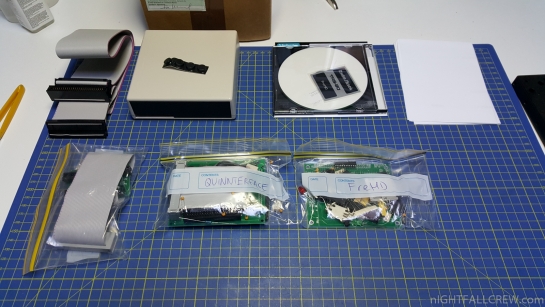
Some new games or tools (Cracked / Trained or Unrealeased) for Commodore 64 have been released from your favorites groups.
Titles:
- Split Second [seuck]
- Matador ’16 [seuck]
- The Uni-Games Preview
- Super Monaco GP +6DG
- QuarxProbe
- Voidrunner +4DH
- Space-Games +
- Oligofrenico +2T
- Rock Star Ate My Hamster +2DG
- R.I.O.T. Preview +
- Knightshift Preview
- Polar Pierre +2D
- Toddlerplane Preview
- Slavia 2
- TasWord 64 [dutch]
- Pickle’s Pod Patrol +7H
- QWAK +4HF
- Icicle Race +2M
- Platman +7H
- Granny’s Garden &DGIS
- Xenophobe +3DFR
- Donald Duck’s Playground [dutch]
- Psytron [dutch]
- Shotgun +
- Shotgun
- Pentagram
- You Go Squish Now! 003 – Barney the Dinosaur
- The Happiest Days of Your Life +3DM &Map
- KGB Agent +4DH
- Workman +5H
- Here & There with the Mr. Men &D
- Nightshade +3DFH
- QWAK +3
- Warp Drive +3
- Pentagram V1.10
- Ski or Die [1581]
- Scare Bear +4DGH
Download: All Games in One Archive (3622)
source: csdb.dk
 Hoxs64 written by David Horrocks is a Commodore 64 emulator for Microsoft Windows 2K/XP/Vista/Seven (DirectX 9+)
Hoxs64 written by David Horrocks is a Commodore 64 emulator for Microsoft Windows 2K/XP/Vista/Seven (DirectX 9+)
The emulator substantially reproduces this legacy machine in minute detail.
Changelog:
- Fix VIC where a write to the raster compare register was causing a raster IRQ to occur one clock too soon. This fixes “Vandalism News #64″
Download:
source: hoxs64.net

DirMaster is a Windows-based GUI application designed to help Commodore enthusiasts explore and manage their disk image collections.
DirMaster supports common (and uncommon) emulator disk image formats (such as .d64, .d81, .d2m, etc), almost every native Commodore archival format (such as .arc, .sda, .lnx, etc), and many native graphic formats (such as koala, doodle, amica, etc).
DirMaster was designed to give users a perfect blend of familiar appearance (e.g. natural looking disk image contents using the PETSCII character set) and modern GUI functionality (e.g. drag and drop, opening multiple disk images at once). The first version of DirMaster was released in 2006.
v3.1.1 addresses a few bugs reported by users:
- Issue opening NAT partitions (.dhd)
- .dhd performance (no md5, .dhd BAM)
- Horizontal BAM display (.d71)
- Disk initialization when unzipping a 1-4! zipcode set when dragged from Explorer.
Download: DirMaster v3.1.1 (1336)
source: style64.org/dirmaster
 Scene World is a C64 magazine on disk dedicated to various activities of both C64 scenes.
Scene World is a C64 magazine on disk dedicated to various activities of both C64 scenes.
“Both” means, that we are supplying information and texts of both scenes; NTSC and PAL.
Download: Scene World #26 (1117)
source: sceneworld.org

Ikari has released a new firmware for the SD2Snes Flash Cartridge (Super Nintendo/Famicom). The upgrade instructions can be found here.
Changelog:
- SD2Snes folder is always hidden again.
- Fixes:
- Fix garbled time on initial clock setting (new unit or battery replacement)
- Fix BS-X not booting/booting incorrectly after soft reset.
- Fix OBC1 being always disabled.
- Fix firmware crash when saving after using the serial command line.
Download: SD2Snes Firmware v0.1.7b (950)
source: sd2snes.de

This is a program that can playback .SID files found in the HVSC collection on a real Commodore 64/128.
You will find different versions of SP64 in this package, most of themwill work on all devices. But I suggest you use the correct version for for your device, since they might contain special commands.
Versions of the program:
- sidplay64-reu-1541u2cmd.prg – 1541 Ultimate II version with REU.
- sidplay64-reu-sd2iec.prg – SD2IEC version with REU.
- sidplay64-reu-1541u-netdrive.prg – 1541 Ultimate & Netdrive with REU.
- sidplay64-reu-iec-cmd-ide64.prg – CMD drives, IDE64 devices & other IEC devices, with REU.
- sidplay64-reu-normal.prg – REU version for 1541, 1571, 1581 and clones of these.
- sidplay64-1541u2cmd – 1541 Ultimate II version.
- sidplay64-normal.prg – Standard version for 1541, 1571, 1581 and clones.
- sidplay64-1541u-netdrive.prg – 1541 Ultimate & Netdrive.
- sidplay64-iec-cmd-ide64.prg- CMD drives, IDE64 devices & other IEC devices.
- sidplay64-sd2iec.prg – SD2IEC.
(The 1541U2 software iec mode has been disabled for this build.)
Changelog SIDPLAY 64 v1.10 (17/04/2016):
- Added: IEC/CMD/IDE64: ClrHome key loads more filenames while reading directory.
- Added: IEC/CMD/IDE64: Joystick RIGHT loads more filenames while reading directory.
- Behaviour: BASIC sid’s that stops on its own can be exited by pressing CBM.
- Added: Songs with BASIC start support.
- Added: REU: Remembers previous dir positions when you go back.
- Added: REU: File size are displayed in kilobytes. (Not for 1541u2)
- Behaviour: Restore : resets variables and reloads dir.
- Behaviour: RunStop+Restore : exit BASIC sid’s or sid’s using $0000 as play call.
- Fixed: 1541U2: shortened dir read routine.
- Fixed: One of the color skins used dark grey for border.
Download: SIDPlay 64 (SP64) v1.10 (1122)
source: sourceforge.net
Sorry, this entry is only available in Italian.

Ikari has released a new firmware for the SD2Snes Flash Cartridge (Super Nintendo/Famicom). The upgrade instructions can be found here.
Here’s what’s new since preview 4:
- Configuration menu. All settings are now available through the menu. Changes take effect immediately after confirming a setting with the A button. It can use some polish but should work fine. Note that the Video Mode settings are only effective on SuperCIC modded consoles.
- SRM files (save files) are now stored in sd2snes/saves/<romname>.srm – existing save files will be moved upon save, there is no batch migration.
Game fixes:
- DMA de-initialization has been reintroduced and changed from $00 to $ff. This reflects a real SNES better and hopefully finally fixes sprite corruption with SGnG and SSF2, AND title screen glitches/crashes with Pocky&Rocky US.
MSU1 enhancements:
- MSU1 volume boost: In case MSU1 audio is too quiet you can now increase volume in several steps. Available via Configuration->Chip Options.
- Interpolation filter to reduce aliasing, resulting in cleaner sound.
- Fixed a bug where volume calculation introduced DC offset to the waveform output. This eliminates clicking or humming on volume changes/fades.
- Changed MSU1 audio playback rate to exactly 44100Hz to match bsnes/higan implementation. Sound that syncs on bsnes should now also sync properly on sd2snes.
- MSU1 resume feature implemented (Thanks to Michaël Larouche!)
Miscellaneous:
- Missing ROM files are automatically removed from the “Recent Games” list. (Thanks to borti4938!)
- Background text is now properly greyed out in the SPC player.
- Ultra16 awareness (mostly thanks to borti4938!):
- Ultra16 serial number and autoboot setting is displayed in the System Information screen.
- Exiting from the SPC player doesn’t crash the menu anymore on Ultra16 consoles.
- Soft reset is prolonged a bit on Ultra16 consoles so you have the opportunity to release the controller buttons, not entering the Ultra16 menu by accident.
- Auto region patching is disabled on Ultra16 consoles so it doesn’t interfere with the Ultra16’s own facilities.
Critical & Minor bugs:
- Firmware locked up when loading Zelda 3 after soft-reset. I am surprised that it actually worked so well with all other games.
- Auto Region Patch setting wasn’t saved properly.
- Satellaview custom time had a garbled default value (year 1035). The default has now been fixed. If you’d like to apply it you can delete your config.yml or just the “BSXTime” entry from it to load the new default.
Download: SD2Snes Firmware v0.1.7a (928)
source: sd2snes.de

DirMaster is a Windows-based GUI application designed to help Commodore enthusiasts explore and manage their disk image collections.
DirMaster supports common (and uncommon) emulator disk image formats (such as .d64, .d81, .d2m, etc), almost every native Commodore archival format (such as .arc, .sda, .lnx, etc), and many native graphic formats (such as koala, doodle, amica, etc).
DirMaster was designed to give users a perfect blend of familiar appearance (e.g. natural looking disk image contents using the PETSCII character set) and modern GUI functionality (e.g. drag and drop, opening multiple disk images at once). The first version of DirMaster was released in 2006.
Some of the new stuff in v3.1.0:
- .d1m (read/write)
- Windows Explorer right click context menu, “Extract All Here”: extracts all files from the disk or archive file into the same directory.
- Add %H parameter to run in, to convert filename to $ hex characters.
- File properties adds file size in bytes and md5 hash.
- Ctrl x/c/v in a directory window will cut, copy, and paste files to and from the clipboard (mimics Windows Explorer behavior)
- Mouse over a sector in the BAM shows the file name and sector.
- Selecting a file will number the linked sectors in the BAM.
- Tweaks to batch output (html, seq, txt, csv), GEOS file handling, disk error handling (23/24/27/29), sfx/sda title handling, PETSCII tool.
- Bug fixes addressing d2m, d4m, d81, t64, g64, nib and other general functions.
Download: DirMaster v2.2 from Style (1120)
source: style64.org/dirmaster

2 x Commodore Amiga 600 Full Recap and Repair.
Commodore Amiga 600 #1:
- Full SMD Capacitors Recap.
- Replaced the joystick port with a missing two pins. The joystick port has been recovered from a pcb (not amiga) for spare parts.
Gallery:
Commodore Amiga 600 #2:
- Full SMD Capacitors Recap.
Gallery:

TRS-80 Model 1 L2 – Video Snow Shovel Hardware Fix
Video snow, the black streaks against white characters, is most apparent with large, rapidly changing areas of white graphics. The root of the problem is that the TRS-80 display is memory mapped by the CPU.
The solution is to give the video circuitry higher priority than the cpu.
Note:
On my TRS-80 Model 1 where i use the Quinnterface & FreHD i had to use the version that also includes the 74LS125 which seemed optional but in this case it does not appear to be optional, we have to do it, otherwise doesn’t work.
Thanks to Ian Mavric for the support.
Gallery of the hardware mod:
Download: 80 Microcomputing Magazine 1982 (833)

One of the most famous limitations of the TRS-80 Model I was its inability to display lower case characters.
Although the lower case characters were present in the character set, the Model I lacked the extra memory chip needed to store the bit corresponding to lower case.
The significance of this limitation has been exaggerated over time (it is worth noting that at that same time the Apple II also lacked lower case), but it created a real problem for word processors. Many lower case upgrades for the Model I were created to address the omission, ranging from simple to more complex.
The TRS-80 video display uses a dedicated block of 1024 bytes of memory located in memory space at 3C00 Hex. When received from the factory, there are only 7 memory chips installed in this block of memory, providing 128 possible characters for screen display. The stock TRS-80 uses 64 of these combinations for graphics and a second 64 for the upper-case subset of the ASCII character set. Bits 0-5 control the character selection, and the highest bit (bit 7) is used to determine if the character is alpha-numeric or graphic. Bit 6 is missing!
To add lower-case display, bit 6 must be implemented. This may be accomplished by switching the memory chip for bit 7 to bit 6, thereby enabling lower-case letters and eliminating graphics, or by addition of an 8th memory chip. We prefer adding the extra chip. In either case, if you plan to use Level II BASIC, you must include a switch to disable bit 6, or BASIC will place a lot of funny characters on the screen!
Gallery of the hardware mod:
Download: Lowercase characters Hardware mod (1089)
source: trs-80.org

TRS-80 Interfaces in KIT from Ian Mavric and J. Andrew Quinn.
I begin to assemble the kit:
- “Quinnterface” is a Mini Expansion Interface for TRS-80 Model I with 16K. Neat little device is perfect for Model I users who own a 16K Level II unit (which is most of you) but no EI or Disk Drives, and don’t want to modify your Model I with upgraded boot Rom or memory upgrade. The Quinnterface, developed by J. Andrew Quinn from New Zealand, adds 32K RAM and auto-boot functionality to your FreHD.
- “FreHD” SD Card HARD DRIVE Emulator for TRS-80 Model I/III/4.
The complete kit consists:
- Quinnterface.
- FreHD.
- Model 1 Hard Drive Adapter.
- BoHx. A small neat enclosure for your FreHD!
- CD ROM / Stickers and Cables.
Gallery:
source: ianmav.customer.netspace.net.au/trs80/

This is a Sinclair Microvision MTV1B. It’s the second attempt of Clive Sinclair’s to make a small portable television.
Released in 1978, it was the smallest television in the world with a CRT tube. A teeny-tiny 2″ D5-100w CRT made by Telefunken. Powered by 4 x AA or via External Powersupply at 6v DC (Negative at the center of the power connector).
Gallery:
Download: Sinclair Microvision MTV1B Schematics (1326)

The ABC 80 (Advanced BASIC Computer 80) was a home computer engineered by the Swedish corporation Dataindustrier AB (DIAB) and manufactured by Luxor in Motala, Sweden in the late 1970s (first model August 1978) and early 1980s. It was based on the Zilog Z80 running at 3 MHz and had 16 KB RAM, expandable to 32 KB, and 16 KB ROM containing a fast semi-compiling BASIC interpreter.
ABC 80 normally used a dedicated (included) tape recorder for program and data storage, but could also be expanded to handle disk drives (and many other peripherals). Some sound effects could be produced by a Texas Instruments SN76477 sound chip which was connected to an 8-bit output port, but there was no way to control the chip’s features in any detail, so sound was limited to 96 fixed sounds. The monitor was a black and white TV set modified for the purpose (an obvious choice since Luxor also made TVs). The computer had excellent I/O response times, something that was discovered when trying to upgrade to personal computers. The solution was to use a microcontroller that communicated with a PC. The main unit had a reset button as well.
ABC 80 was also manufactured on license as BRG ABC80 by Budapesti Rádiótechnikai Gyár in Hungary. It used the same keyboard, but the case was metal instead of plastic.
The ABC 80 was a huge hit in Sweden, and grasped a majority share of the rising personal computer market thanks to its office software in Swedish. Although the ABC 80 fans would defend the ABC 80 by referring to its good BASIC and usable extension bus, it couldn’t defend the home market against the gaming computers with color graphics and better sound that arrived in the early 80s like the Commodore 64, even though a new cheaper version was released that could use an ordinary TV instead of the dedicated video-monitor.
Luxor held on to its office market for a couple of years longer with the ABC 800 series, which had a more extensive BASIC, more memory and a 512×240 ‘high-resolution’ graphics mode, but otherwise similar performance. In 1985 Luxor also tried to compete in the office market against the IBM PC with its ill-fated ABC 1600 and ABC 9000 series UNIX computers, but failed.
Gallery:
… and the boxes
Software:
source: wikipedia

 Hoxs64 written by David Horrocks is a Commodore 64 emulator for Microsoft Windows 2K/XP/Vista/Seven (DirectX 9+)
Hoxs64 written by David Horrocks is a Commodore 64 emulator for Microsoft Windows 2K/XP/Vista/Seven (DirectX 9+)
 Scene World is a C64 magazine on disk dedicated to various activities of both C64 scenes.
Scene World is a C64 magazine on disk dedicated to various activities of both C64 scenes.







Recent Comments